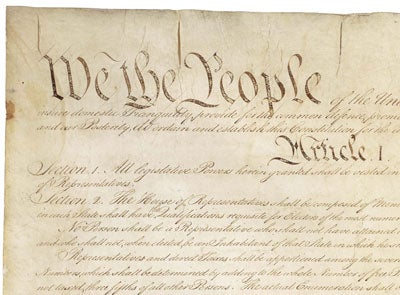How Political Parties Almost Ruined the Constitution
Julia Shaw /

The Constitution is for sale. No, really. Christie’s in New York will auction off George Washington’s 223-year-old copy of the Constitution and Bill of Rights next week.
The pages are largely unmarked, except for a few of Washington’s notes about the presidency. That’s appropriate, considering that Article II was drafted with George Washington in mind. This has largely worked out well, except in one area: the Electoral College for selecting the President.
According to Article II, electors were to meet in their home states and cast two votes. One vote had to be for a candidate from another state. The person with the majority of votes became President; the runner up, Vice President. In the event of a tie, the House of Representatives would select the President. The Electoral College as written in Article II worked perfectly—twice.
The retirement of George Washington and the rise of political parties disrupted the Electoral College. In the election of 1796, Federalists campaigned for John Adams and Democratic-Republicans for Thomas Jefferson. Adams won the most votes and became President, but his intended running mate, Thomas Pinckney, finished third. Thomas Jefferson came in second and therefore became Vice President.
In 1800, The Democratic-Republican candidates trounced the Federalist candidates. But a voting error led to a tie between Thomas Jefferson and his intended running mate, Aaron Burr. The Federalist-controlled House of Representatives would decide which Democratic-Republican would become President. It took some 36 ballots and backroom dealing before Jefferson became President and Burr Vice President.
Americans realized that without a mechanism to vote for a President and Vice President separately, the Electoral College could fail to select a President, leaving the House of Representatives to settle each election.
The 12th Amendment corrected this problem. It was ratified 208 years ago today.
Under this amendment, electors vote for President and Vice President separately. The House of Representatives selects the President if no candidate receives a majority of electoral votes; the Senate has the same power for the Vice President. Since the 12th amendment, only one election has been settled in the House: 1824.
But there’s a larger lesson here. The Constitution is a stable document. The amendment process has contributed to this stability. When political parties disrupted the function of the Electoral College, the Framers amended the Constitution to fix the problem. The Constitution that we have today is basically the same one George Washington owned. The Constitution has endured for more than two centuries, thanks to the wisdom of the Framers and, when necessary, the amendment process.
